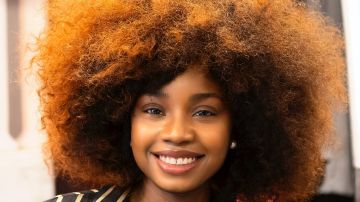Texture Discrimination in The Curly Hair Community Is Real and Problematic
“You have that good curly hair,” an acquaintance of mine told me after a brief discussion about hair

Photo: Unsplash/@davefrancis101
“You have that good curly hair,” an acquaintance of mine told me after a brief discussion about hair. “I have those tighter curls. That ‘pelo malo” like they say.’ It’s 2018 and the term “pelo malo” still makes me cringe the way it did when I was little girl. But I’m always especially surprised when I hear it come from Latinas (like my acquaintance) and Black women who proudly sport their natural curls. It’s like they are sending a mixed message to the world. With all the progress we’ve made in the natural hair community, you’d think the words “bad hair” or “pelo malo” would no longer be a thing. But the truth is, they aren’t going away as long as texture discrimination is still around.
I first learned about texture discrimination through my best friend and roommate, Marisha Clarke. I had an idea more or less of what it was, but was unaware of the term and didn’t realize the damaging effects it was having on brown and Black women.
“Texture discrimination is the belief that a certain type of hair texture is more desirable than others,” says Clarke. “For instance, a loose bigger curl is better than a smaller spring-like curl. In most cases, curls that have less definition and more shrinkage are considered to be unattractive. With all things that the majority doesn’t find palatable, the textures that are disliked are not represented. That is, unless someone makes a conscious decision to do so.”

The curl texture Clarke is referring to has a name and it’s usually referred to as 4C. In the natural hair community there are different names for different curl patterns, in order to help women understand their texture and how to care for it. Type 2 hair textures tend to be more on the wavy or big loose curls side. Type 3 tend to be tighter than type 2 curls but more on the medium range like Shakira, Zendaya, and Halle Berry. My curls are around the 3A range.
Texture discrimination against 4C or kinkier curl types with less curl definition is in fact a thing and if you don’t believe – get on YouTube. With just one quick search I found a number of videos from curly hair vloggers and influencers on how harmful this mentality really is.
Curly hair vlogger, JustLostJC opens up in her video titled “Who REALLY hates 4B/C Hair – Texture Discrimination” about how tighter kinkier textures get less love even in the curly/natural hair community. She even points out how videos with softer, looser, and more defined curl patterns tend to get a lot more views.
We may not realize it, but by showing preference to one curl texture over another, we are essentially taking steps back in our progress. We are again idealizing the idea that the “Blacker” less “Eurocentric” our hair is, the less beautiful it is. The fact that words like “bad hair” or “pelo malo” are still being used among curly haired women themselves, proves we still have a ton of work to do.
In fact, one woman who chose to be quoted as anonymous, claims that she notices a big difference from when she wears a curly haired wig with a softer texture versus when she wears her natural, and kinkier texture out.
“Most people think my natural texture is a looser curl than it is,” she says. “Because of that people mention how nice it is. When I’ve worn my actual hair out, I don’t receive compliments. ‘Natural hair’ is finally more desirable when it comes to castings but the ‘natural hair’ is still a looser curl or in my case – a weave or wig.”
This is dangerous because of the negative messages it sends women about what it means to be beautiful.
“Whenever things are labeled as “good” this means something has to be “bad,” says Amira Lamb, a professional fitness trainer, coach, and bodybuilder with naturally curly hair. “When someone puts a negative label on themselves that has detrimental effects to someone’s feelings of self-worth and self-acceptance. It also elevates people to a status of being better when hair texture is really unimportant.”
Like all types of discrimination, texture discrimination also creates divisions between brown and Black women.
“There are so many things that cause division between members of Black and brown communities, texture discrimination is just another way of making women compare themselves to others and feel “less than” because of their appearance,” adds Clarke. “Anytime there is division among people of color, it holds us back. We need to become more united and not let these ideas tear us apart and, ultimately, weaken us.”
The same way it can cause women with tighter textures to feel inferior, it can also create a different kind of complex for curly haired women with so-called “good hair.”
Hortencia Caires, is a Brazilian model and curly hair influencer who receives hair comments on Instagram regarding her voluminous curls on a regular basis. She’s even had Black women accuse her of being a white woman appropriating black hair, regardless of the fact that Caires family has African, indigenous, and European descent, which would explain her mixed hair.
“I understand the battle between the textures, my hair type is 3B to 3C and would say it’s slightly more accepted than someone with 4A to 4C. Given the fact that we barely see any mainstream [media] promoting it, I’d say they’re right,” says Caires. “I can sympathize with people with tighter and kinkier textures because it’s harder to manage and the media has done a poor job embracing it. However, I’ve dealt with my share of hate and feel that we shouldn’t be fighting with each other about who struggles more, but instead embrace and understand. We don’t know what that person has gone through to finally love their hair. In the end, everyone’s journey is different.”
“Out of frustration, women are tearing each other down based on their hair type. We should all stick together as women of color and not go against each other,” says Christina Vega, a professional makeup artist and curly hair influencer who has been told she doesn’t belong in the natural hair community because her curls aren’t “tight enough” and her skin “isn’t dark enough.” “Texture discrimination is like the big elephant in the room. I think for a while this was something people noticed but didn’t speak of. I think the more we bring light to this topic, the faster we can get to the root of the problem and fix it.”
Natural hair is the hair that naturally grows from your scalp and everyone’s natural hair story or journey is different. It’s an individual thing, meaning no one should have the right to tell someone if their hair is or isn’t beautiful. The whole premise behind the natural movement was for women of color to finally break free from the oppressing Eurocentric beauty standards that have been placed on us for centuries. It was about owning your natural beauty, and honoring the beautiful features passed down by your ancestors. But texture discrimination does the opposite. It once again sets a standard that sets women apart and triggers unhealthy comparisons. We really need to get to a point where we’re no longer finding ourselves praising one kind of beauty or one kind of hair type while ignoring other types of beauty and other types of hair types. The change really starts with us.
“We need to become more aware of these attempts to divide and conquer people of color. When we have these thoughts, we can question ourselves and the validity of these ideas,” says Clarke. “When we have dealt with ourselves, we can move outward and help others realize that the texture of our hair and our skin complexion should have nothing to do with our worth as humans. All hair is beautiful in it’s own way and they all need to be celebrated.”
[article_ad]

















